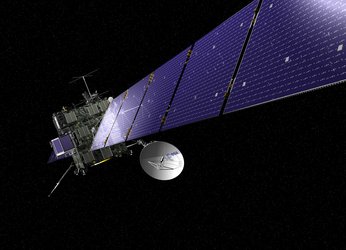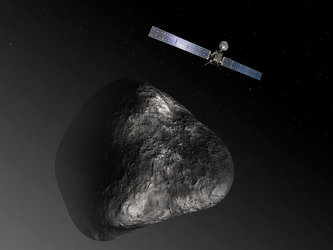

Rosetta spacecraft
Thank you for liking
You have already liked this page, you can only like it once!
Artist view of ESA's Rosetta cometary probe. The spacecraft is covered with dark thermal insulation in order to keep its warmth while venturing into the coldness of the outer Solar System, beyond Mars orbit.
Selected in November 1993 as a cornerstone mission of ESA's long-term science programme, the Rosetta probe was launched by an Ariane 5 on 2 March 2004, on an 11-year journey to the comet 67P/Churyumov-Gerasimenko.
Built by EADS Astrium, the Rosetta probe consists of a 3,065-kg spacecraft (1,578-kg dry mass) designed to enter orbit around the comet's nucleus in August 2014 after a series of gravity assist manoeuvres to gain enough orbital energy, with three swing-bys at Earth (March 2005, November 2007 and November 2009) and one at Mars (February 2007). En route to the comet, the probe will flyby the asteroids 2867 Steins (September 2008) and 21 Lutetia (July 2010).
The spacecraft carries 11 science instruments to probe the comet's nucleus and map its surface in fine detail. It will also land a package of instruments (the Philae Lander) to study some of the most primitive, unprocessed material in the Solar System. The mission will provide clues to the physical and chemical processes at work during the formation of planets, beginning 4.6 billion years ago.
-
CREDIT
ESA, image by AOES Medialab -
LICENCE
ESA Standard Licence

Rosetta spacecraft

Rosetta spacecraft

Rosetta spacecraft

Rosetta at comet

